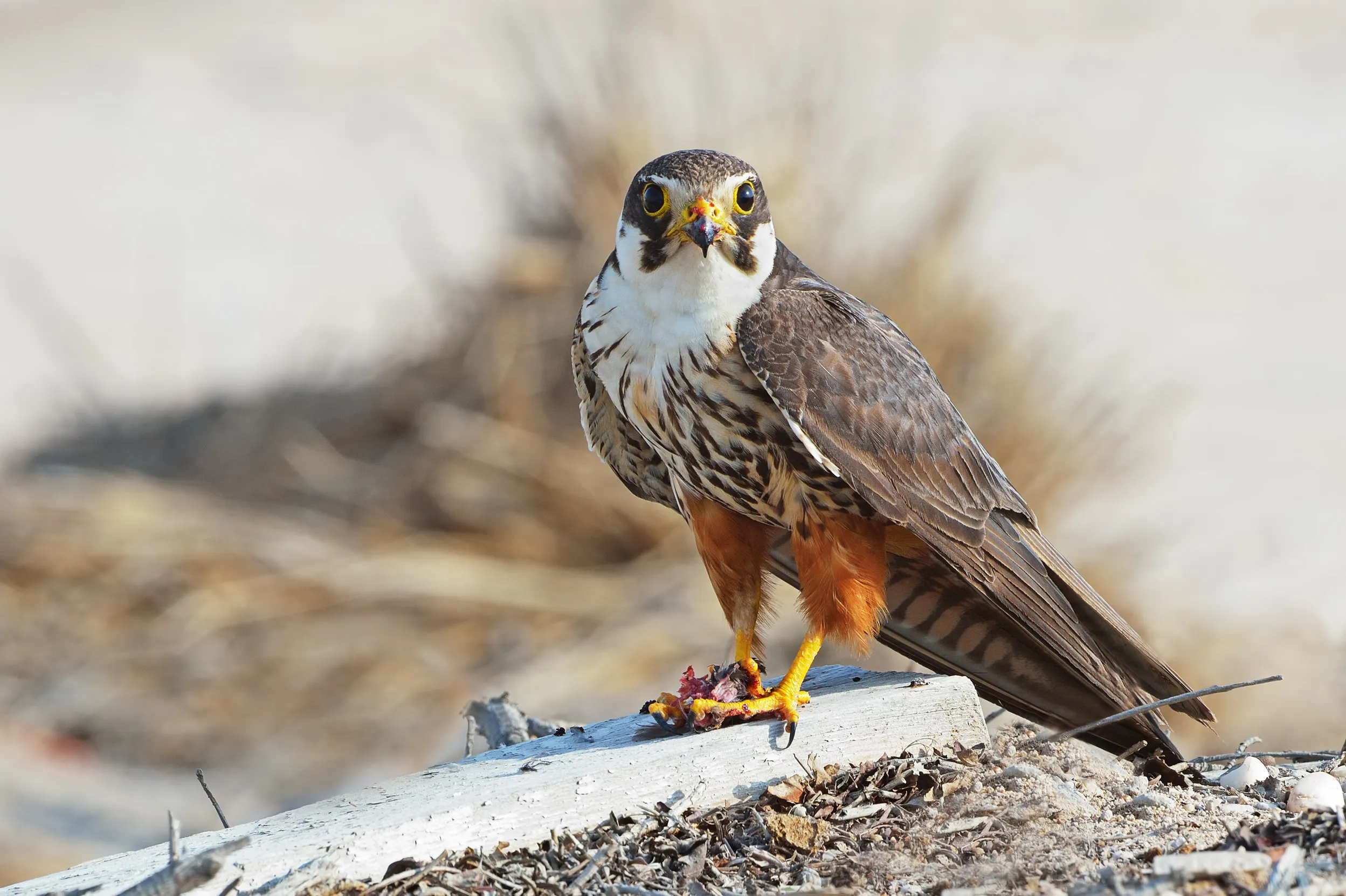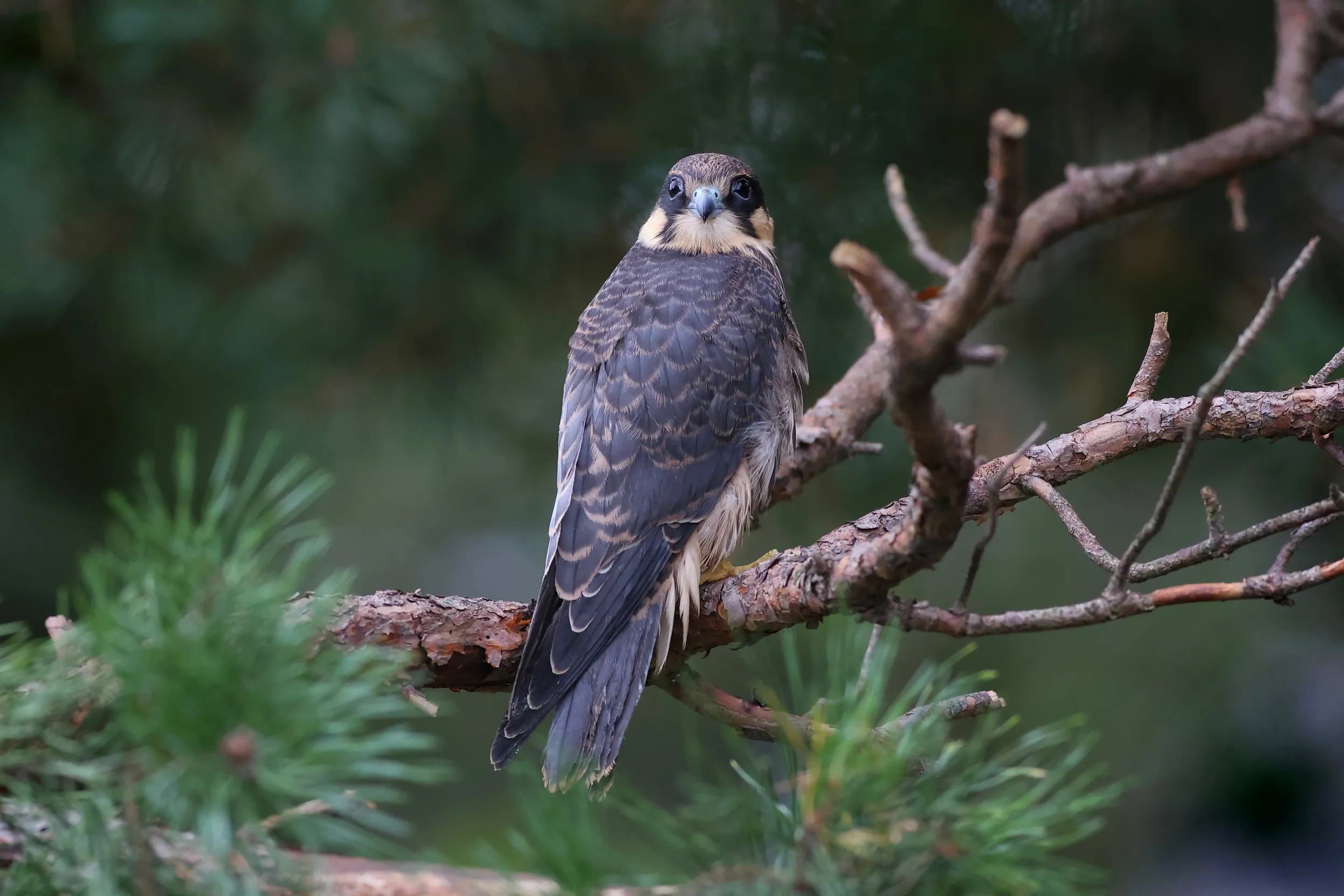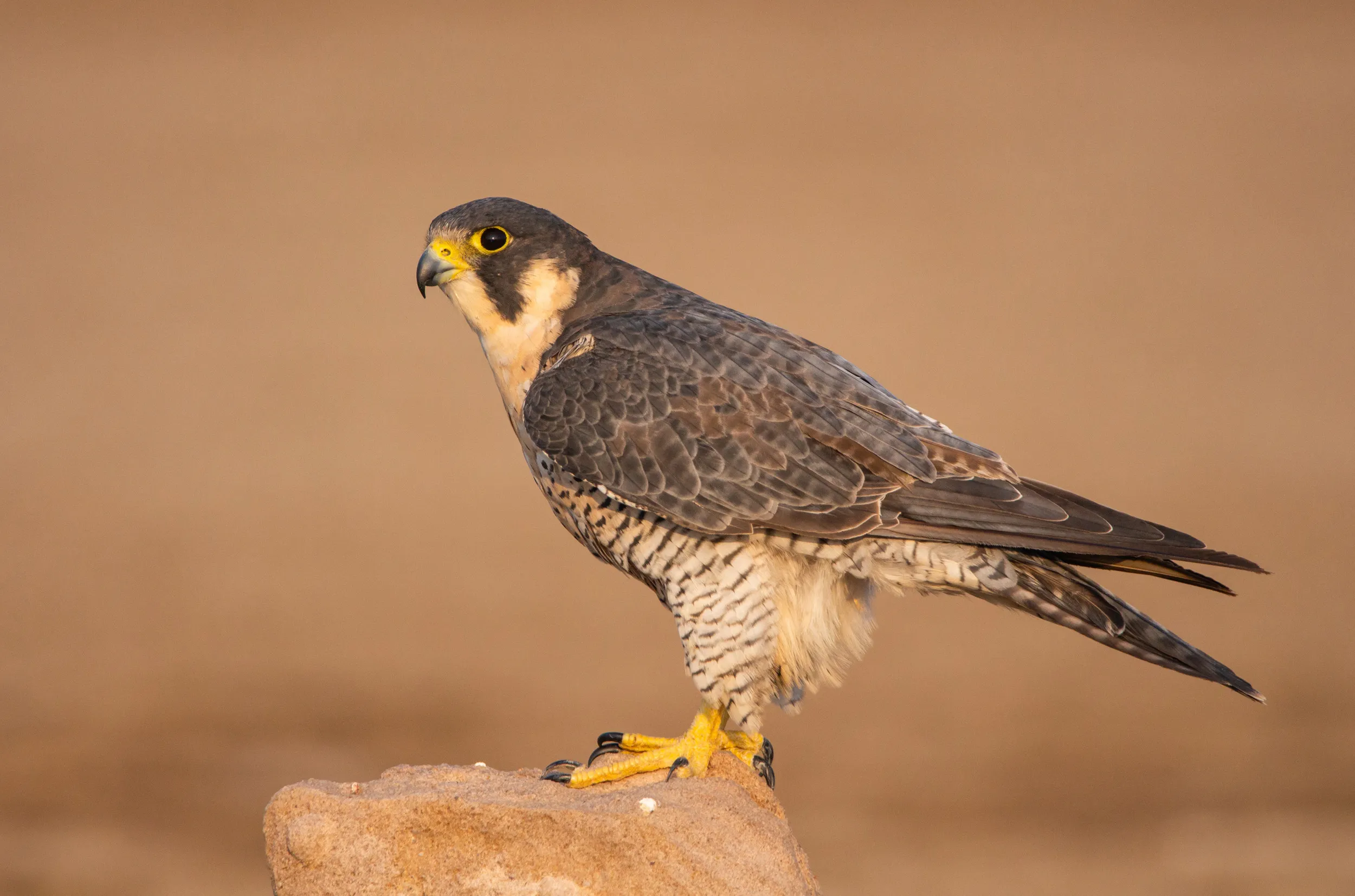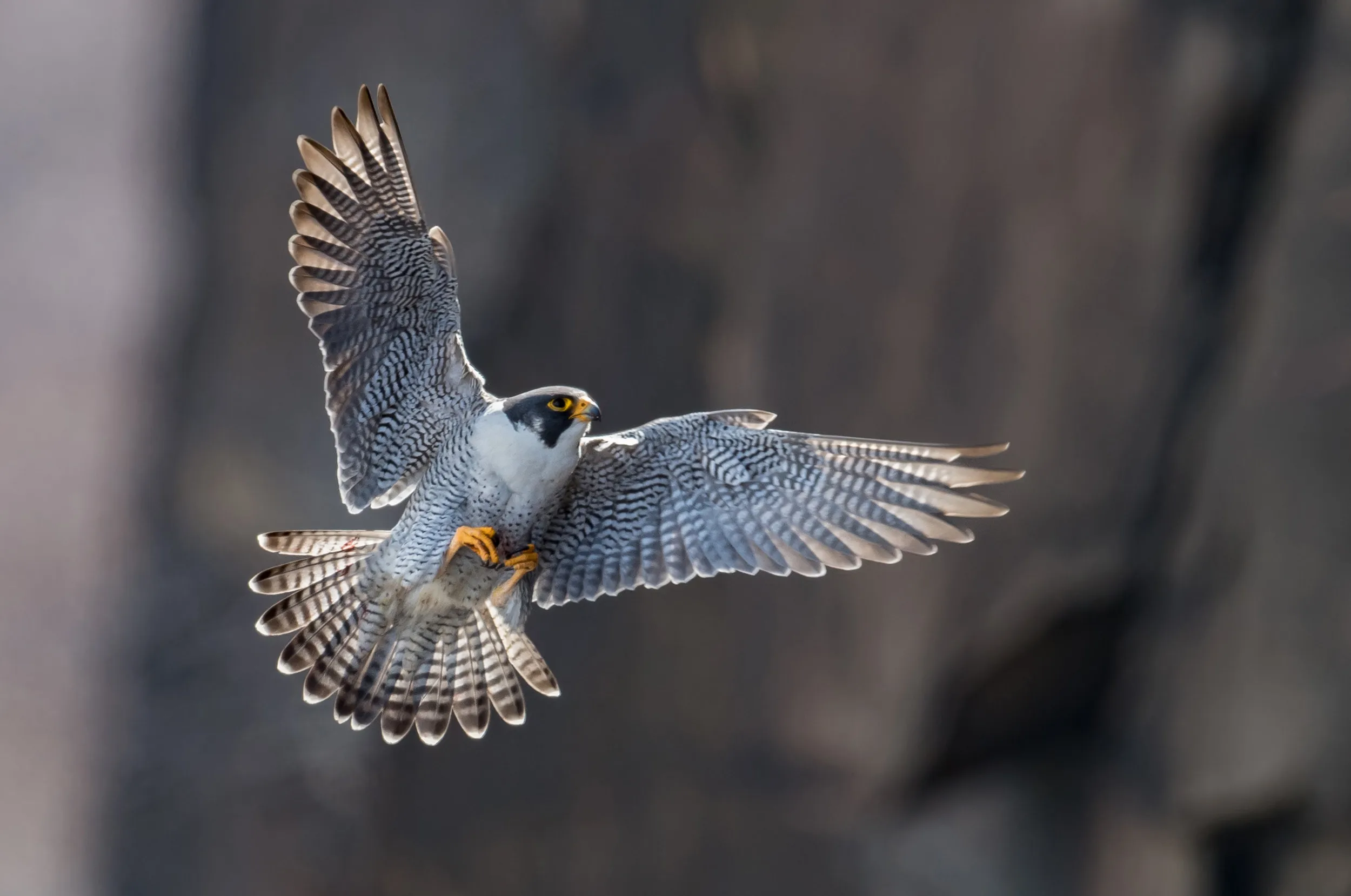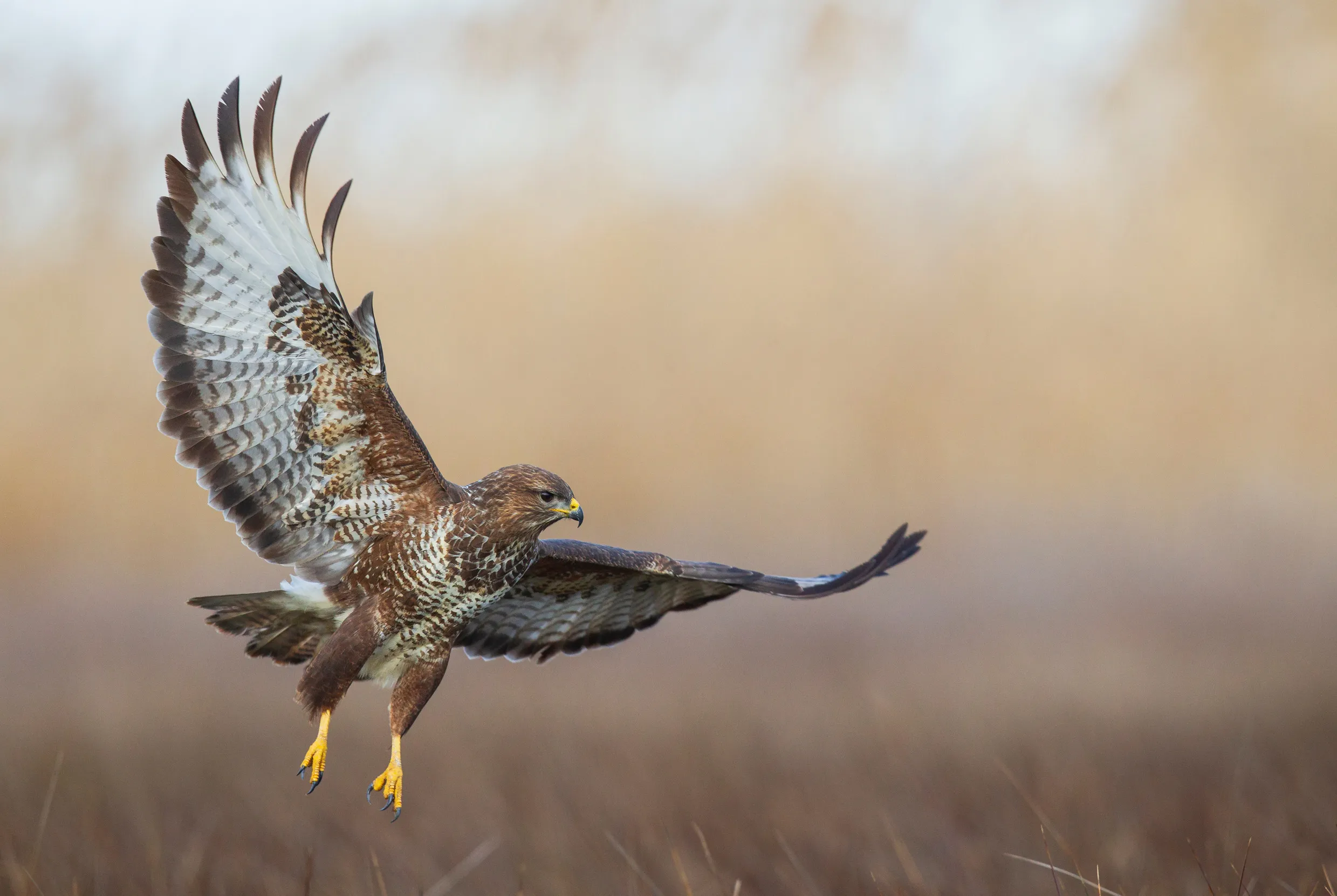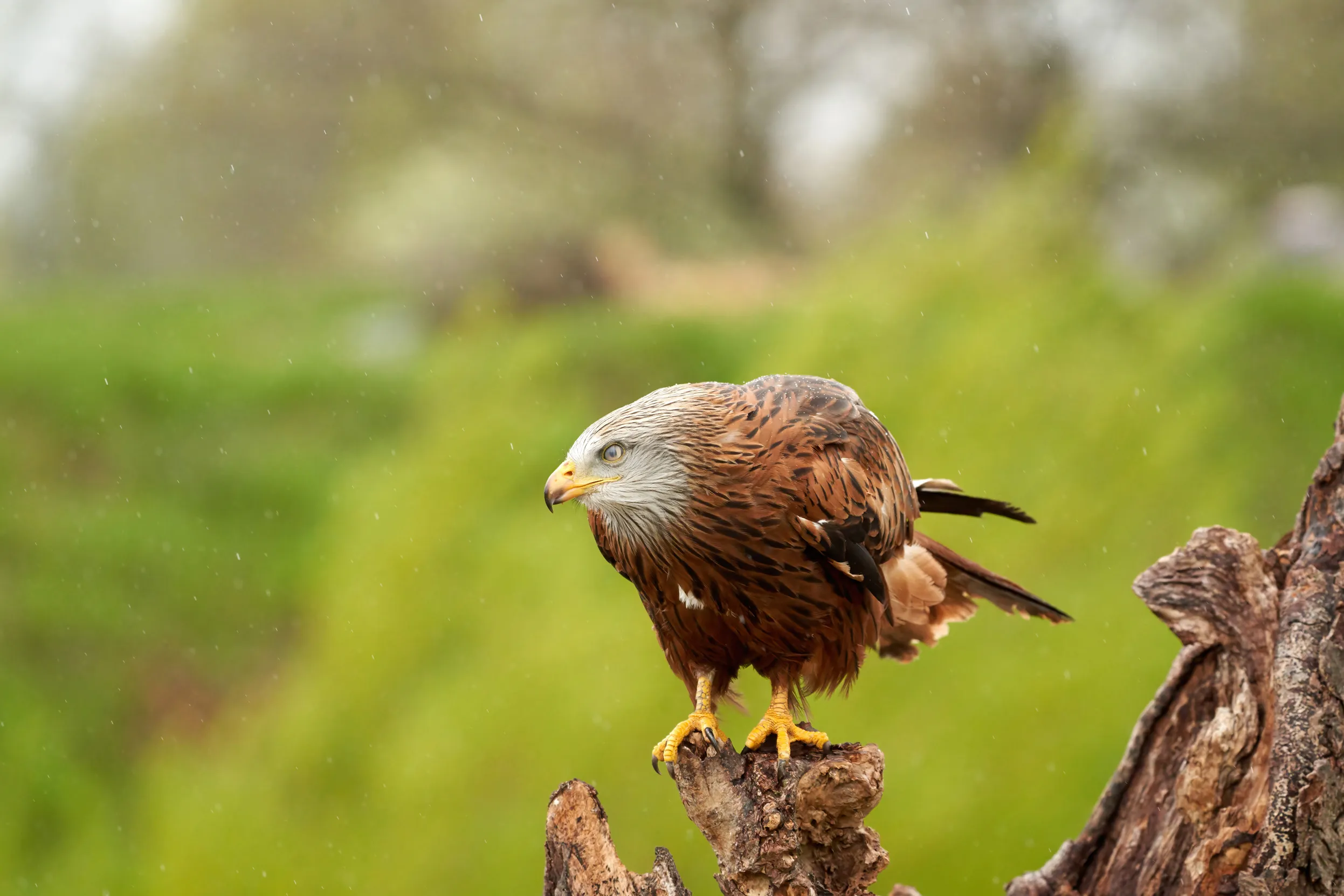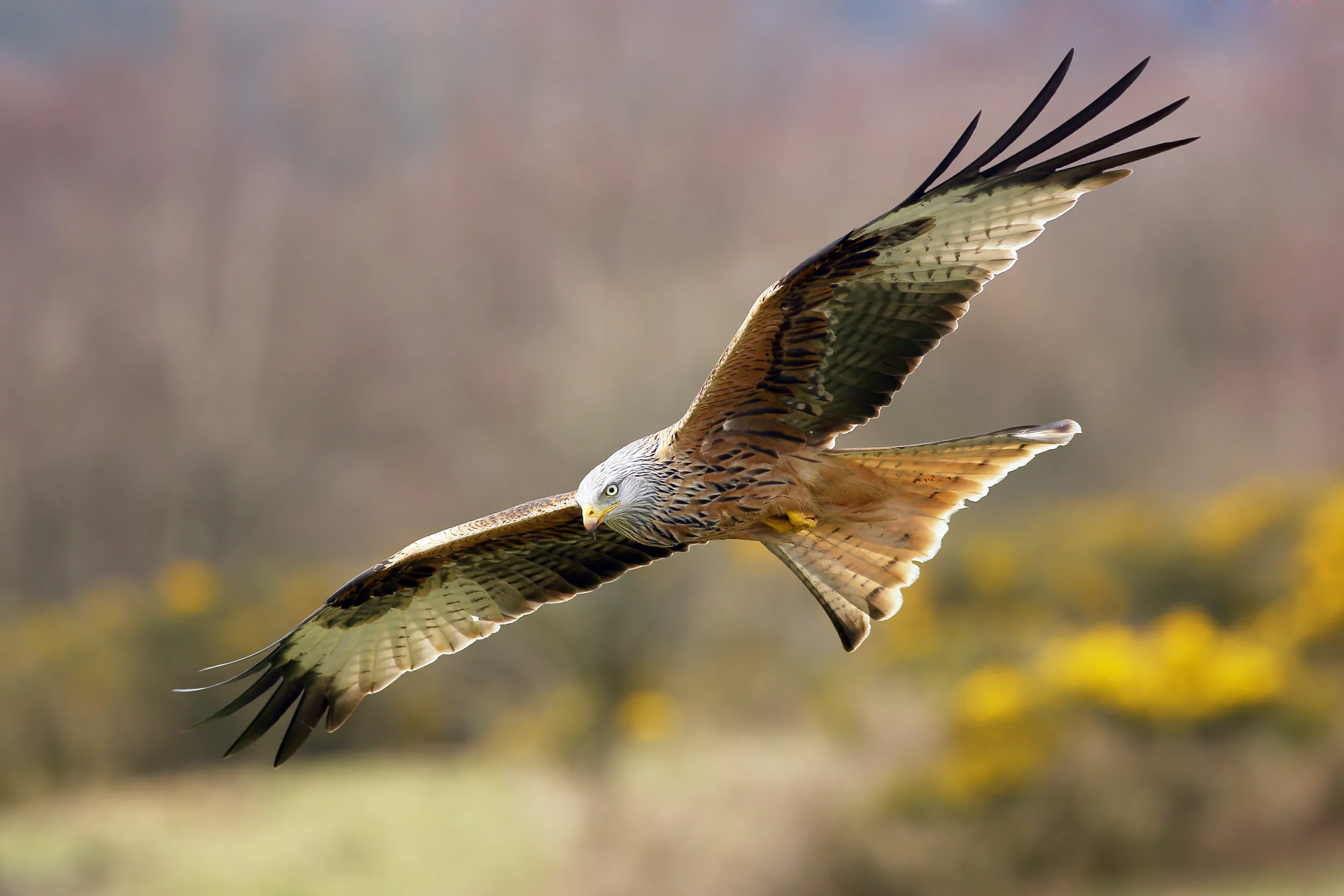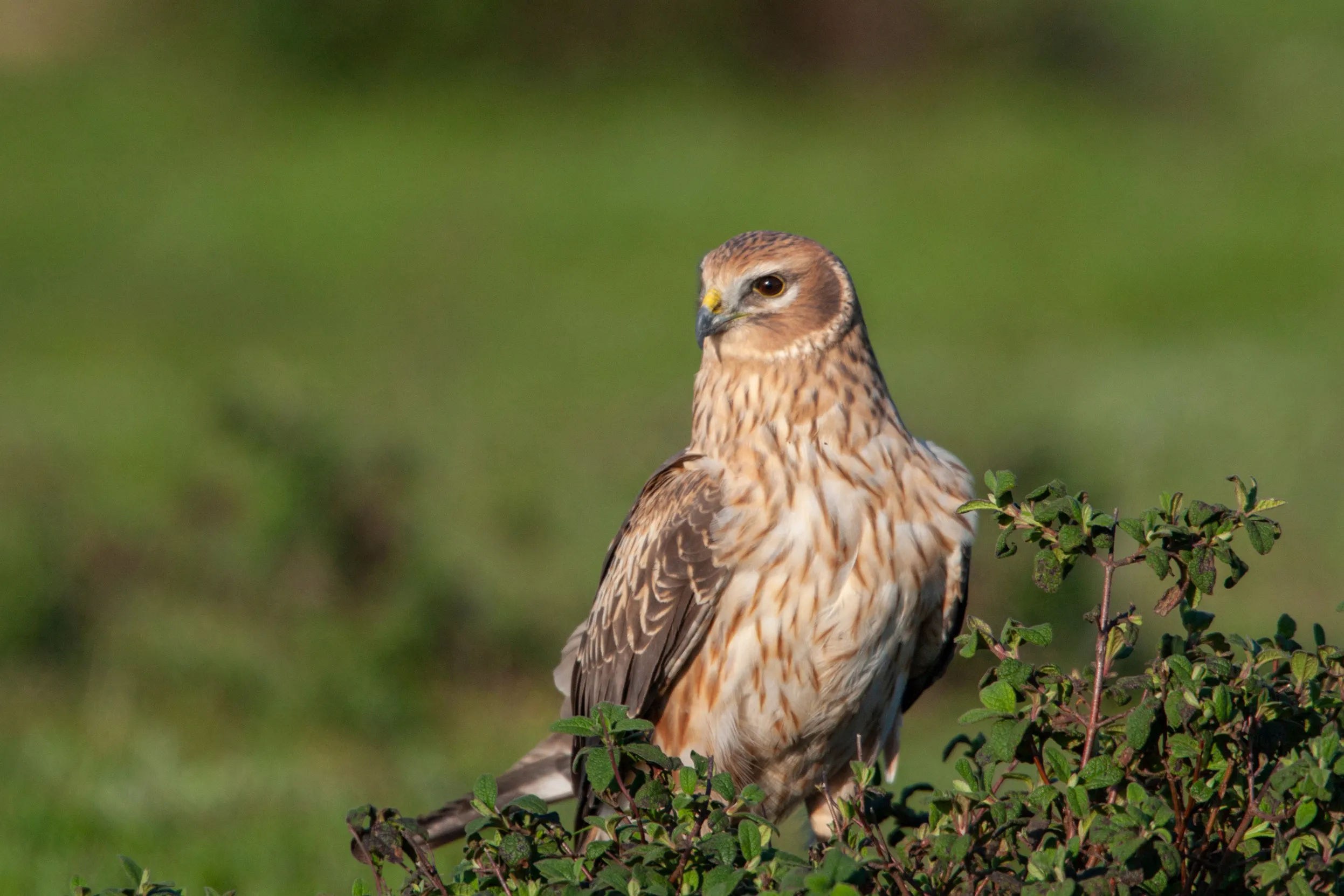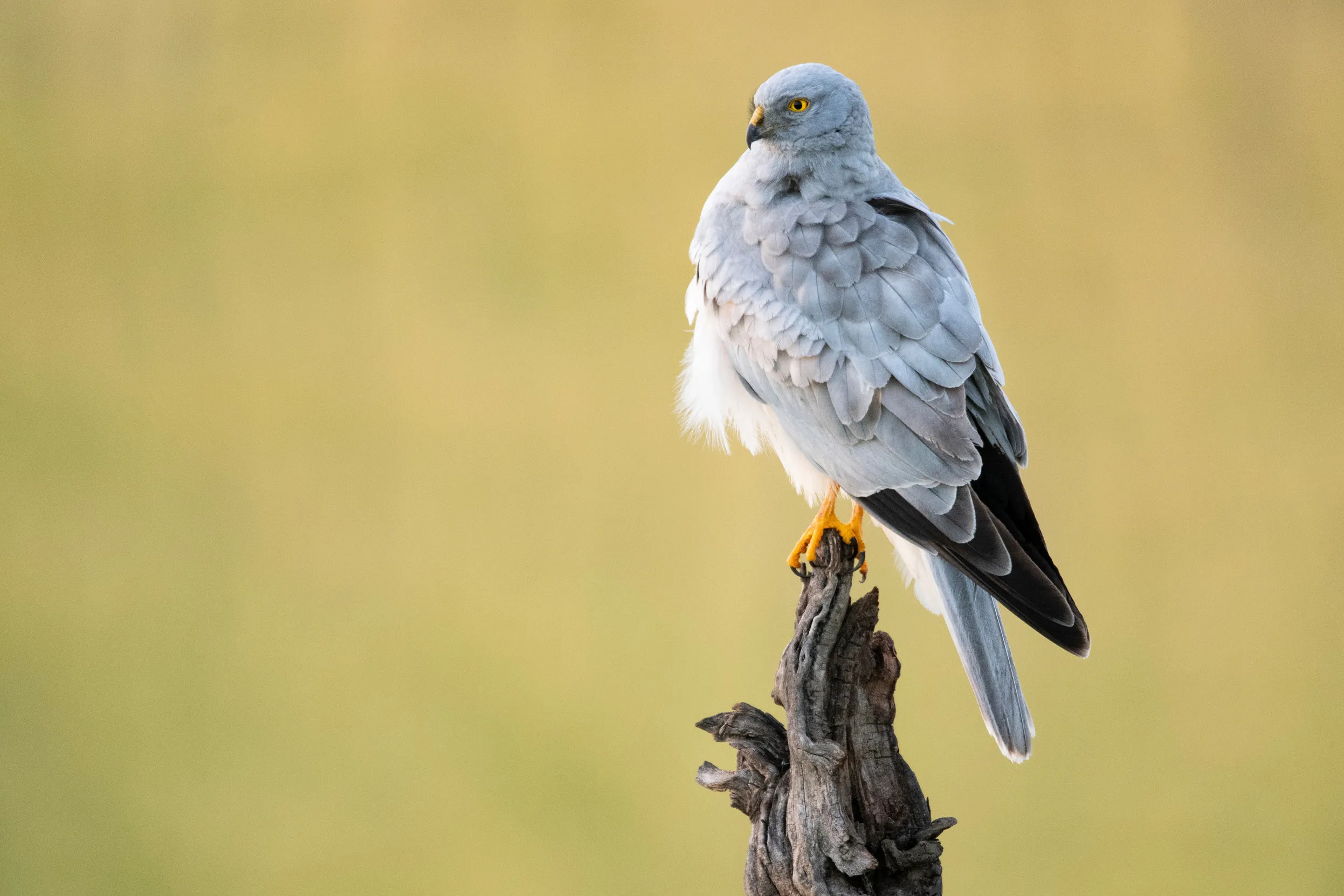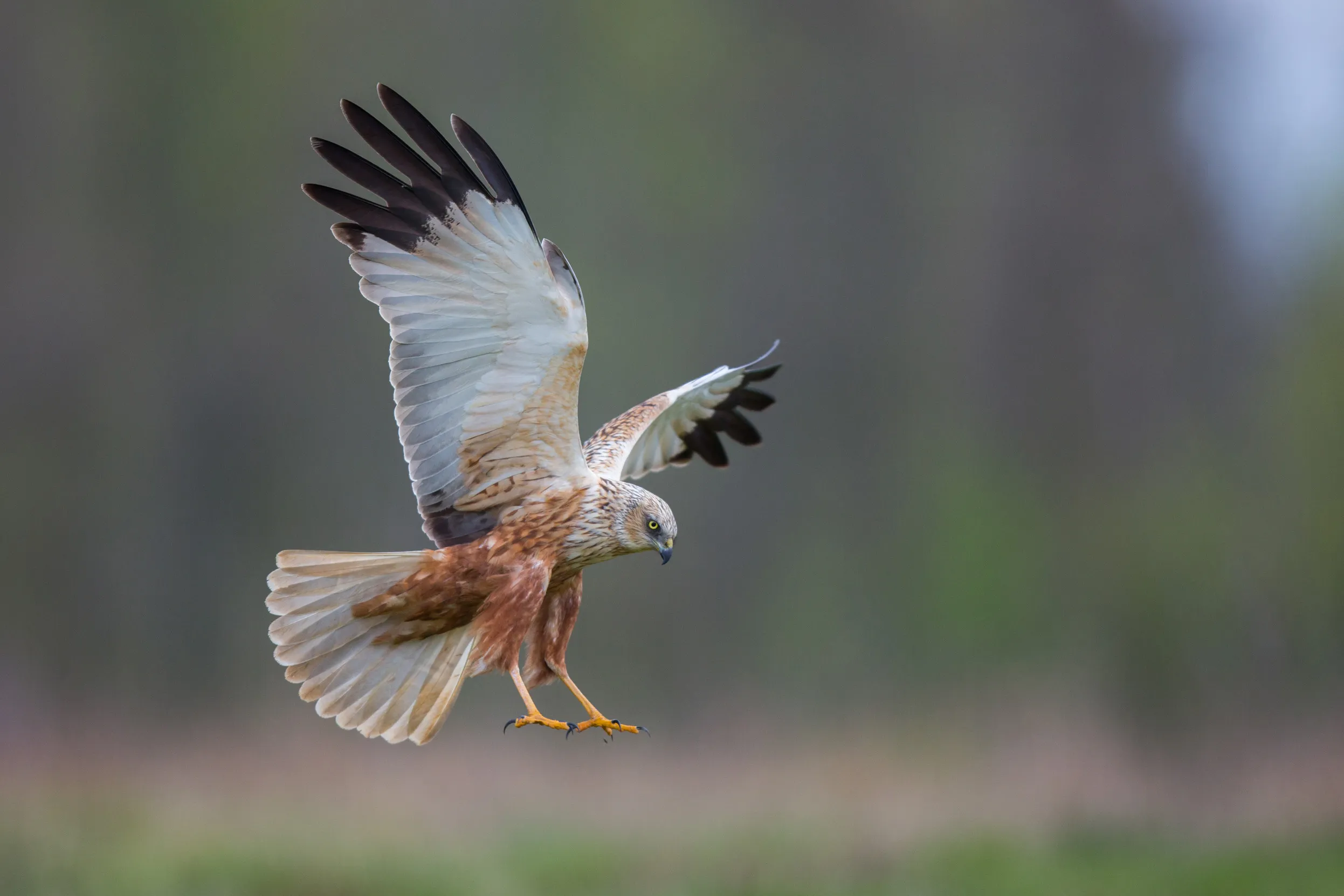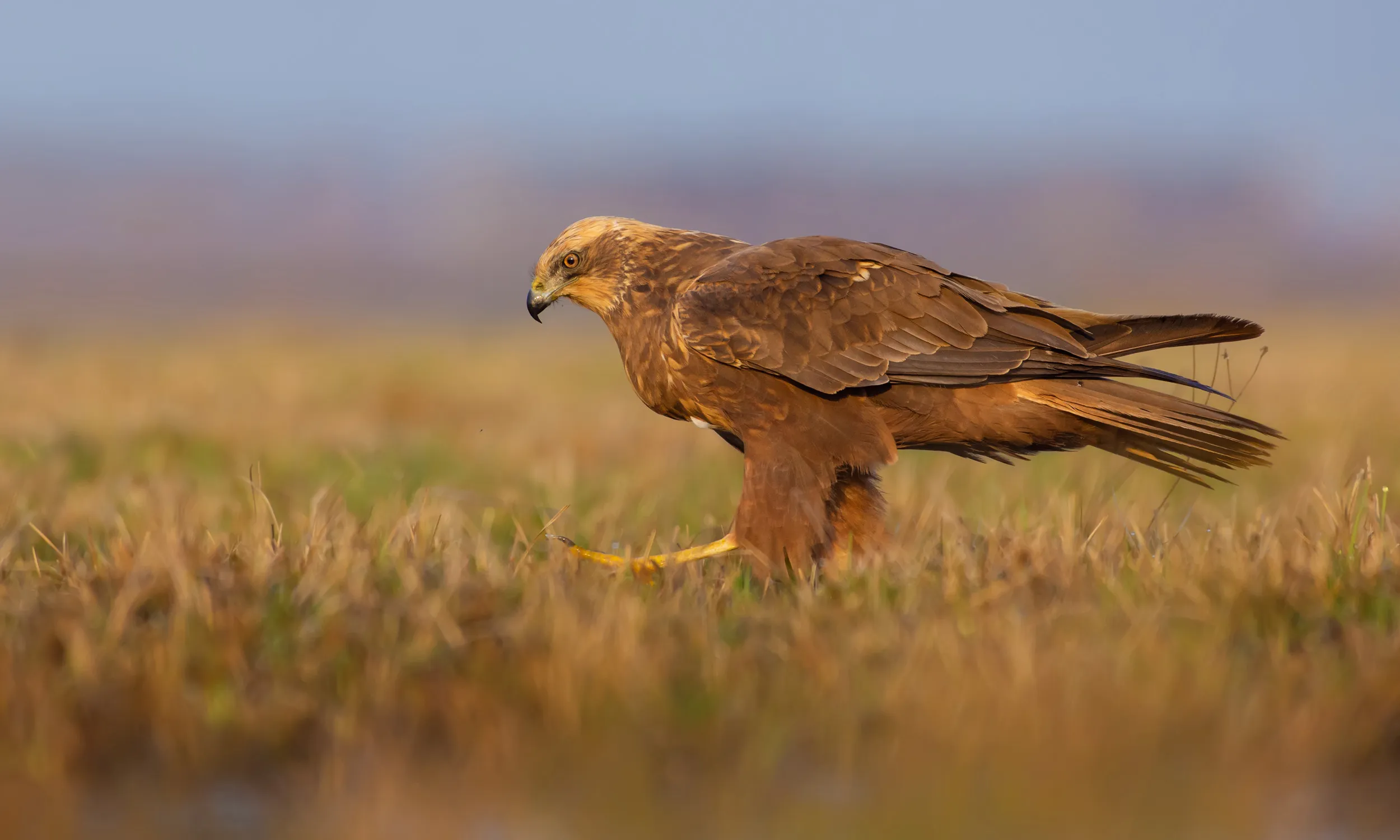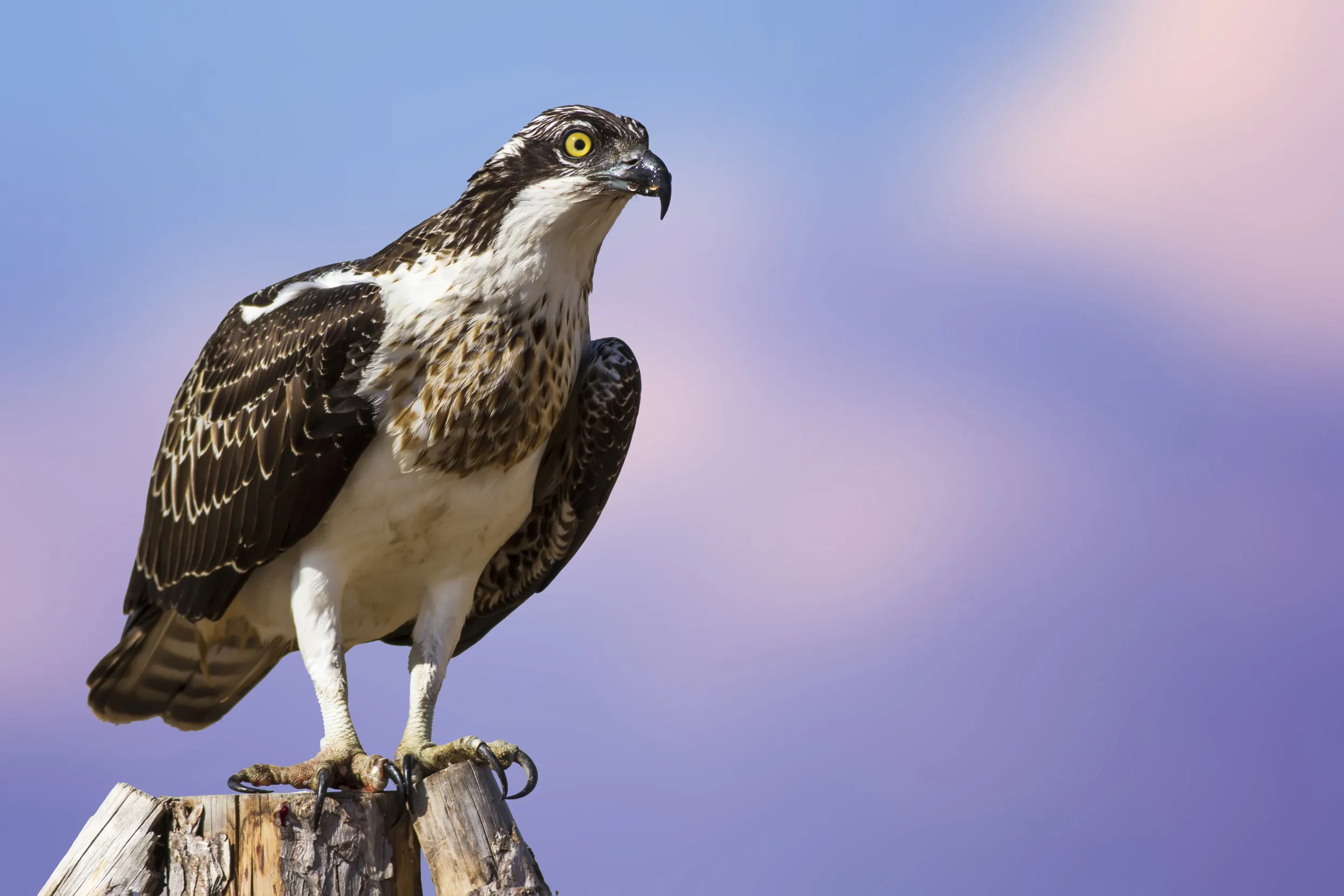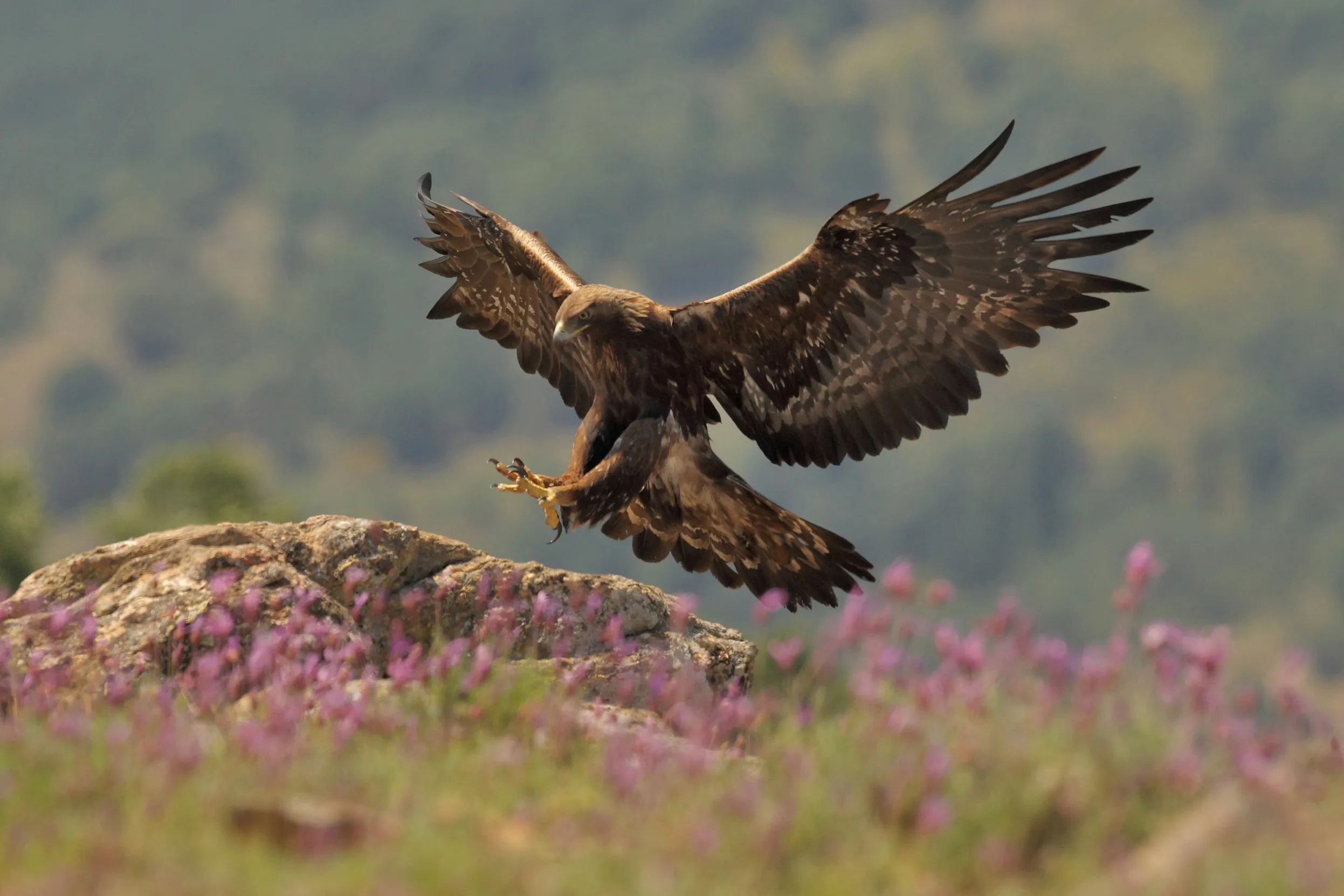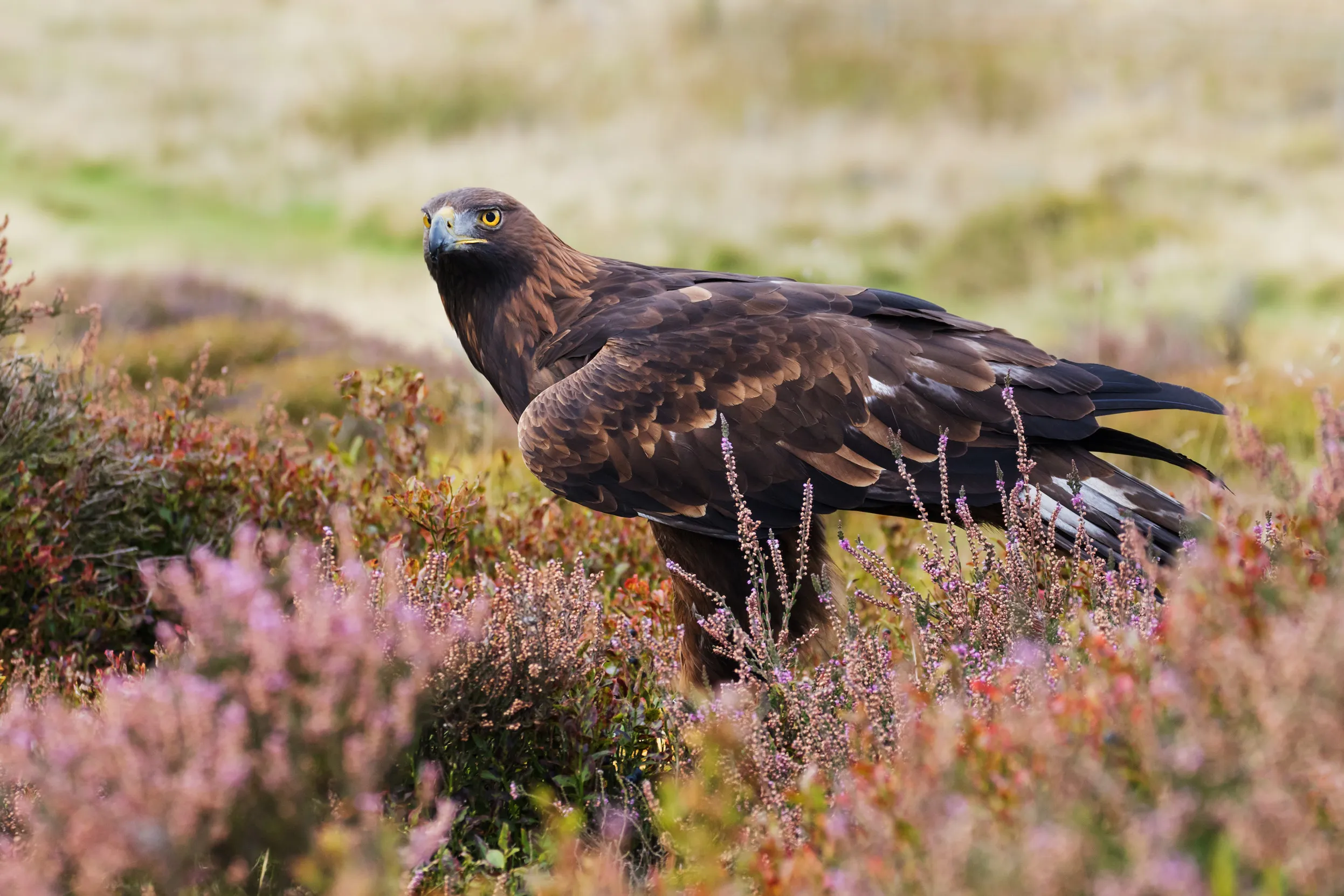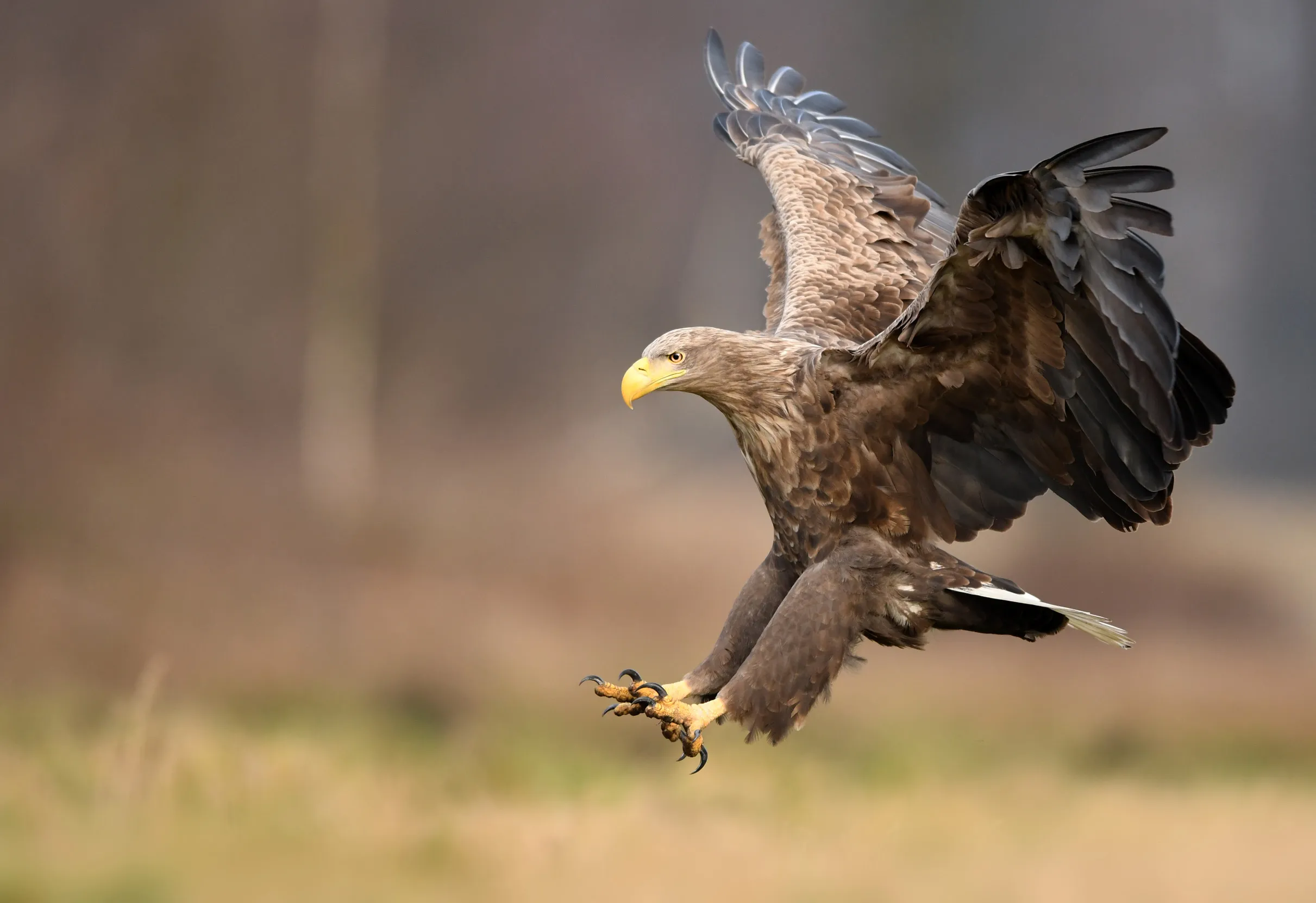- Length: 32–35cm
- Wingspan: 71–80cm
- Weight: 156–252g
Birds of prey identification guide
Many UK birds of prey species look quite similar, which can make identifying them a challenge. In this guide, we share some simple ID tips to help you.

On this page
Small birds of prey
Kestrel
Conservation status - Amber
Key features to look out for
- Both males and females have pale undersides with black speckles (not bars like on a Sparrowhawk)
- Males have a slate-grey head and uppertail with a single black band at the tip
- Females are browner all over, with bars all along the uppertail
- Both males and females have dark ‘tear’ marks extending below each eye
- Wing tips are more pointed than a Sparrowhawk’s
- Longer tail than other falcons, with a black band at the end. Fanned out while hovering
Behaviour
You’re most likely to see a Kestrel hovering in the air – in fact, this behaviour is so characteristic that it led to the Kestrel’s colloquial name of ‘windhover’. While hovering, Kestrels keep their head still and their eyes fixed on the ground, adjusting their tail and wings to hold position, before dropping down to catch a vole or other small mammal. Kestrels are a familiar sight hovering above road verges, and you might also see them perched on fence posts, scanning the ground for prey.
When to see them
All year round
Where to see them
Kestrels are widespread across most of the UK. They like open habitats where they have a good view of their prey, such as grassland, farmland and heathland, but you might also spot them in towns.
Merlin
Conservation status - Red
Key features to look out for
- The UK’s smallest bird of prey. Males are not much bigger than a Blackbird
- Adult males have a blue-grey back, rusty underparts with dark streaks, and dark outer wing feathers
- Immature males and females are mostly brown, with paler buff underparts streaked with brown
- Narrow, square-ended tail that is shorter than a Kestrel’s
- Dark eyes, unlike a Sparrowhawk
- Small black beak with a yellow base
- Yellow legs
- Merlin's have pointed wings and a very compact shape

- Length: 25–30cm
- Wingspan: 50–62cm
- Weight: males 125–234g, females 164–300g
Behaviour
Merlins are extremely fast and agile, twisting and turning in the air as their chase small birds. They fly with faster wingbeats than other falcons, often followed by short glides where they hold their wings close to their bodies.
When to see them
All year round. In winter, the UK population of Merlins is joined by birds from northern Europe and Iceland.
Where to see them
Merlins breed in the uplands of northern and south-west England, as well as in parts of Scotland, Wales and Northern Ireland. In winter, Merlins relocate to lowland farmland and coastal marshes.
Hobby
Conservation status - Green
Key features to look out for
- About the size of a Kestrel, but with longer, sharply pointed wings. They also have a shorter tail than Kestrels
- When flying they look scythe shaped, like a large Swift
- Adults have slate-grey upperparts, buff underparts with dark streaks, and white cheeks with a black ‘moustache’ and eye mask
- Distinctive russet-red feathers under tail and on legs, which look a bit like trousers
- Juveniles are browner and lack the red ‘trousers’
- Dark eyes with a yellow rim
- Black beak with yellow at the base
- Yellow legs
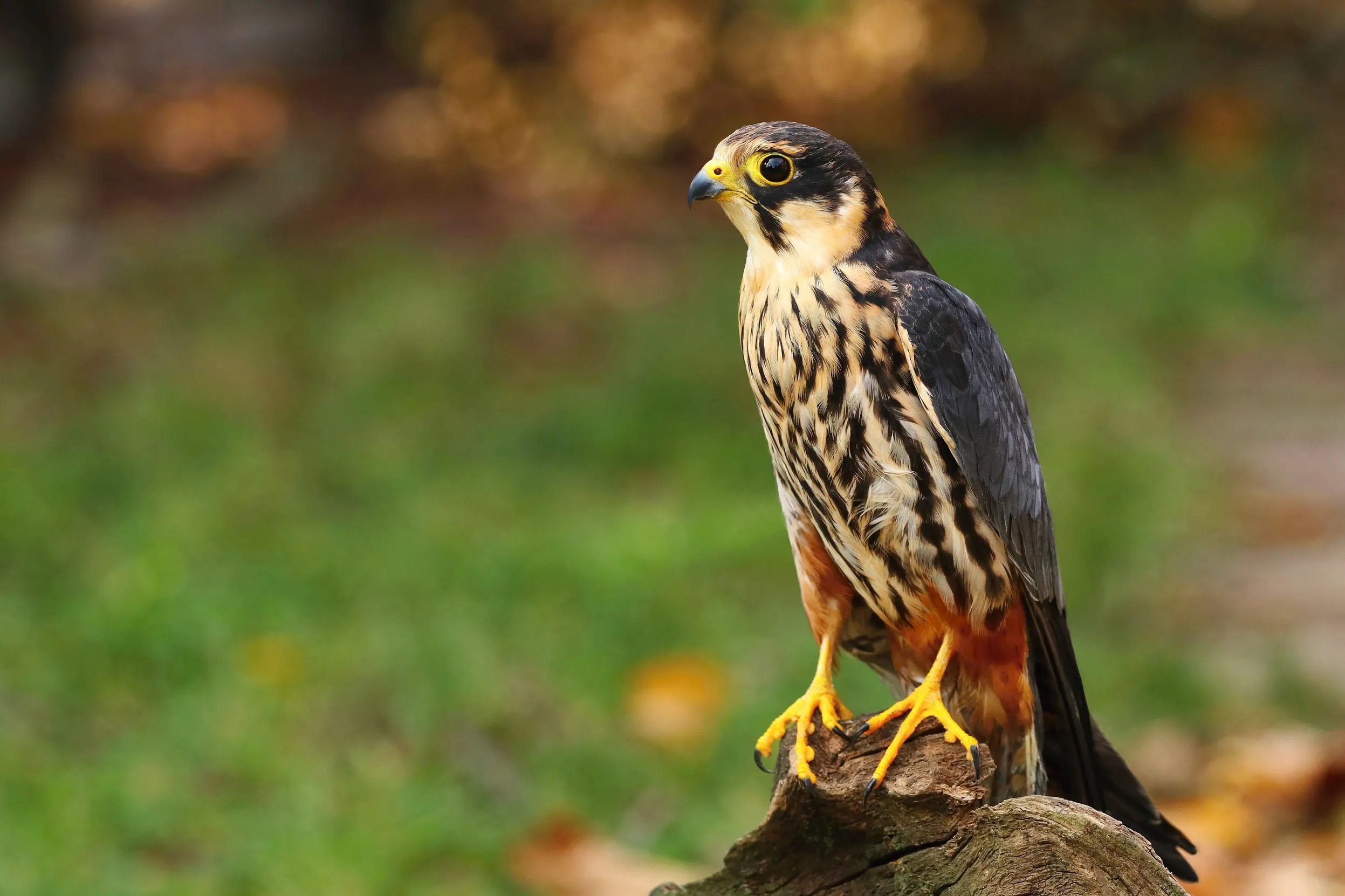
- Length: 28–36cm
- Wingspan: 70–92cm
- Weight: 131–340g
Behaviour
Hobbies catch small birds and insects, such as dragonflies, on the wing, hunting them down in high-speed chases. They often transfer their prey from their talons to their beak mid-flight, something that other falcons don’t do. You might also see them soaring high in the sky, unlike Merlins, which usually fly closer to the ground.
When to see them
Hobbies are summer migrants to the UK, usually arriving in April and leaving again in October, to spend the winter in Africa.
Where to see them
Hobbies hunt over open countryside, including wetlands and heathlands, across much of England and parts of Wales.
Sparrowhawk
Conservation status - Amber
Key features to look out for
- Males have a blue-grey back, and orangey-brown bars on their underparts
- Females and juveniles have a brown-grey back, and pale underparts with brown barring
- Females are much bigger than males
- Both have striking yellow eyes and long, thin yellow legs
- In flight, Sparrowhawks have a T-shaped silhouette, with a long square-ended tail and blunt wing tips
- They have a distinctive ‘flap-flap-glide’ flight pattern
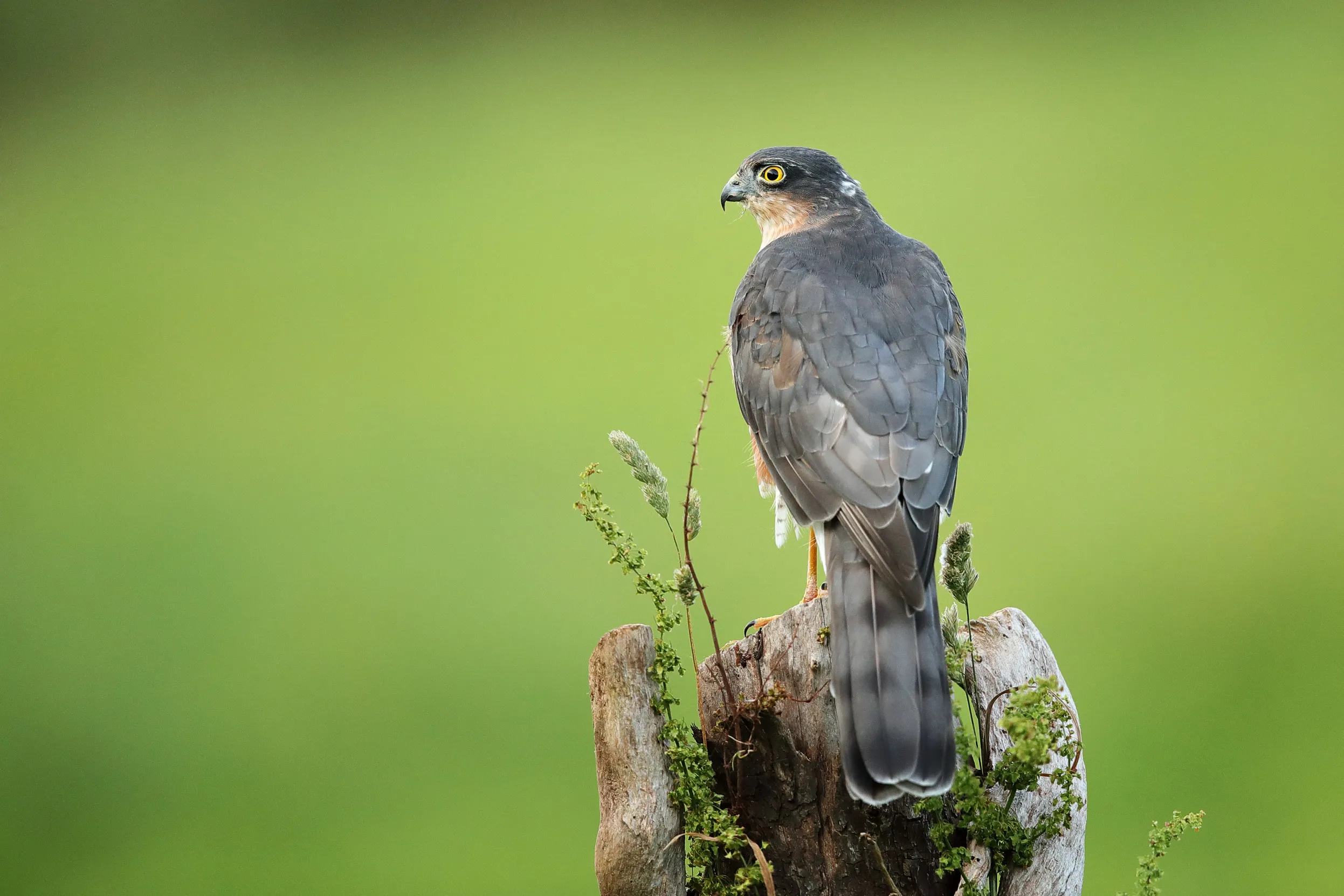
- Length: 28–38cm
- Wingspan: 55–70cm
- Weight: males 110–196g, females 185–342g
Behaviour
Sparrowhawks are woodland birds that have adapted to urban green spaces. They’re fast and agile and hunt by surprise, using buildings and plants as cover before darting out at the last moment to catch small birds. They’re so quick, you might only be alerted to their presence by alarm calls and the sudden scattering of birds from your feeders.
When to see them
All year round
Where to see them
Sparrowhawks are widespread across almost all of the UK, with the exception of parts of Scotland. You could see them in mixed woodlands, farmland and gardens.
Medium-sized birds of prey
Goshawk
Conservation status - Green
Key features to look out for
- They look like much bigger, stockier Sparrowhawks
- Females are about the size of a Buzzard, but males are smaller
- Both have yellow legs, which are thicker than a Sparrowhawk’s
- Adults have a steel-grey back and barred, white chest. They have a prominent white ‘eyebrow’ stripe over their eyes and a dark patch behind their eyes
- Juveniles are brown and have a buff-coloured breast with dark streaks, not stripes
- Eye colour can vary from deep red to orange or yellow, depending on the age and sex of the bird
- In flight, the corners of the tail are more rounded than a Sparrowhawk’s
- They have deeper and slower wingbeats than Sparrowhawks, and can soar for longer periods without needing to flap their wings.

- Length: 48–62cm
- Wingspan: 135–165cm
- Weight: males 600–1,100g, females 900–2,000g
Behaviour
Goshawks are excellent hunters and take a wide variety of prey, including pigeons, crows, squirrels and Rabbits. They hunt like Sparrowhawks, using surprise and agility to sneak up on their prey, and are amazingly adept at flying through tiny gaps in dense woodland undergrowth.
When to see them
All year round
Where to see them
Goshawks are woodland birds, but are very secretive and difficult to see, and are very unlikely to turn up in a garden like a Sparrowhawk. They were persecuted to extinction in the UK, but breeding population has re-established. Today, they’re most common in southern Scotland, Northern England and Wales.
Peregrine Falcon
Conservation status - Green
Key features to look out for
- The UK’s biggest falcon
- Blue-grey above and white below, with dark barring on the chest and belly
- White throat and cheeks, with a dark mask and ‘moustache’
- Jet-black eyes, with a striking yellow eye ring
- Yellow legs and base to beak
- Females are bigger than males, but otherwise they look alike
- Juveniles have buff-coloured underparts, with dark streaks rather than barring on the chest and belly
- In flight, Peregrines have noticeable triangular-shaped wings that taper sharply to a point
- Short, square-ended tail, which is sometimes fanned when soaring
- Length: 39–50cm
- Wingspan: 95–115cm
- Weight: 600–1300g
Behaviour
Peregrines are famous for hurtling out of the sky at high speed to dive-bomb their prey in mid-air. They tend to eat medium-sized birds, such as wading birds and pigeons, but have also been known to take smaller birds, and even bats. In winter, Peregrines that breed in the uplands often move lower down to estuaries and coasts.
When to see them
All year round
Where to see them
Peregrines nest on cliff ledges, quarry faces, crags and sea cliffs, and have recently started using tall buildings, such as cathedrals, in urban areas. The highest densities of Peregrines are in upland areas of Wales, southern Scotland and north-west England.
Buzzard
Conservation status - Green
Key features to look out for
- Usually brown, with white undersides to the wings, but their plumage is quite variable
- Adults have an obvious dark tail band and dark trailing edges to their wings
- Long, broad wings with prominent ‘fingers’
- Buzzards tend to hold their wings in a raised ‘V’ when soaring, whereas Red Kites hold their wings flat, or slightly downcurved
- Short tail, often fanned in flight, which lacks the distinctive fork of a Red Kite’s
- Yellow beak, with a black tip
- Yellow legs
- Often sits with a hunched posture
- Not to be confused with the Honey Buzzard, which is a rare summer visitor to the UK. They glide with their wings held flat, tilting their tail like a kite. Their wings are not held raised in a ‘V’. They are neatly barred underneath, with a prominent small head.
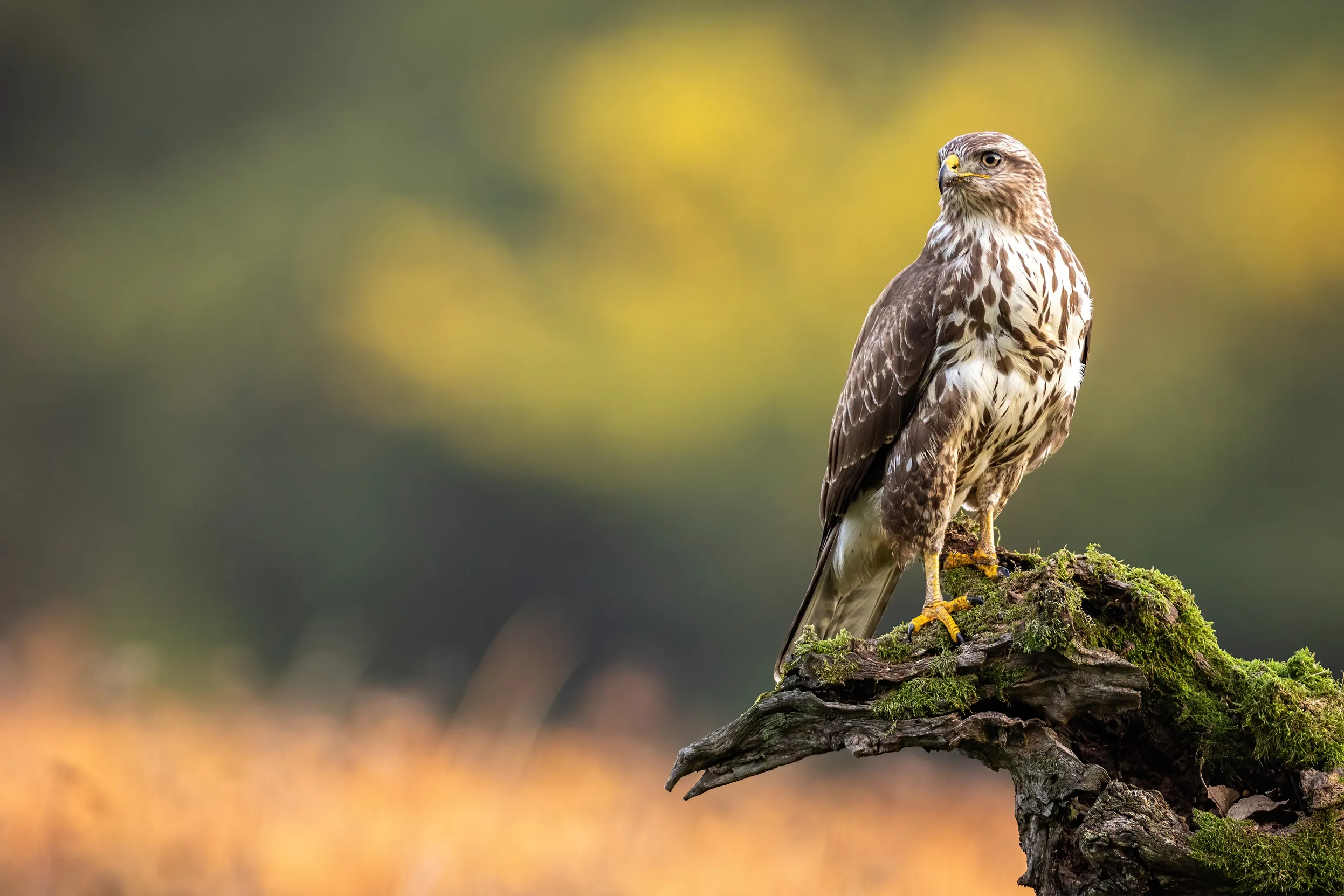
- Length: 51–57cm
- Wingspan: 113–128cm
- Weight: 550–1,300g
Behaviour
Buzzards soar on thermals high above woodlands, open countryside and even motorways, looking for prey, including rabbits, rodents and birds. They often feed on carrion, so you might see them feasting on roadkill, or even patrolling along the ground in search of earthworms.
When to see them
All year round
Where to see them
Buzzards are the UK’s most common bird of prey and can be found almost everywhere. Keep an eye out for them perching on lampposts or fences at the side of roads.
Red Kite
Conservation status - Green
Key features to look out for
- Distinctive long, deeply forked tail
- Angular wings, with white patches underneath and dark fingered wing tips
- Adults have a reddish-brown body with dark streaks and a pale grey head
- Yellow beak with a black tip
- Yellow legs
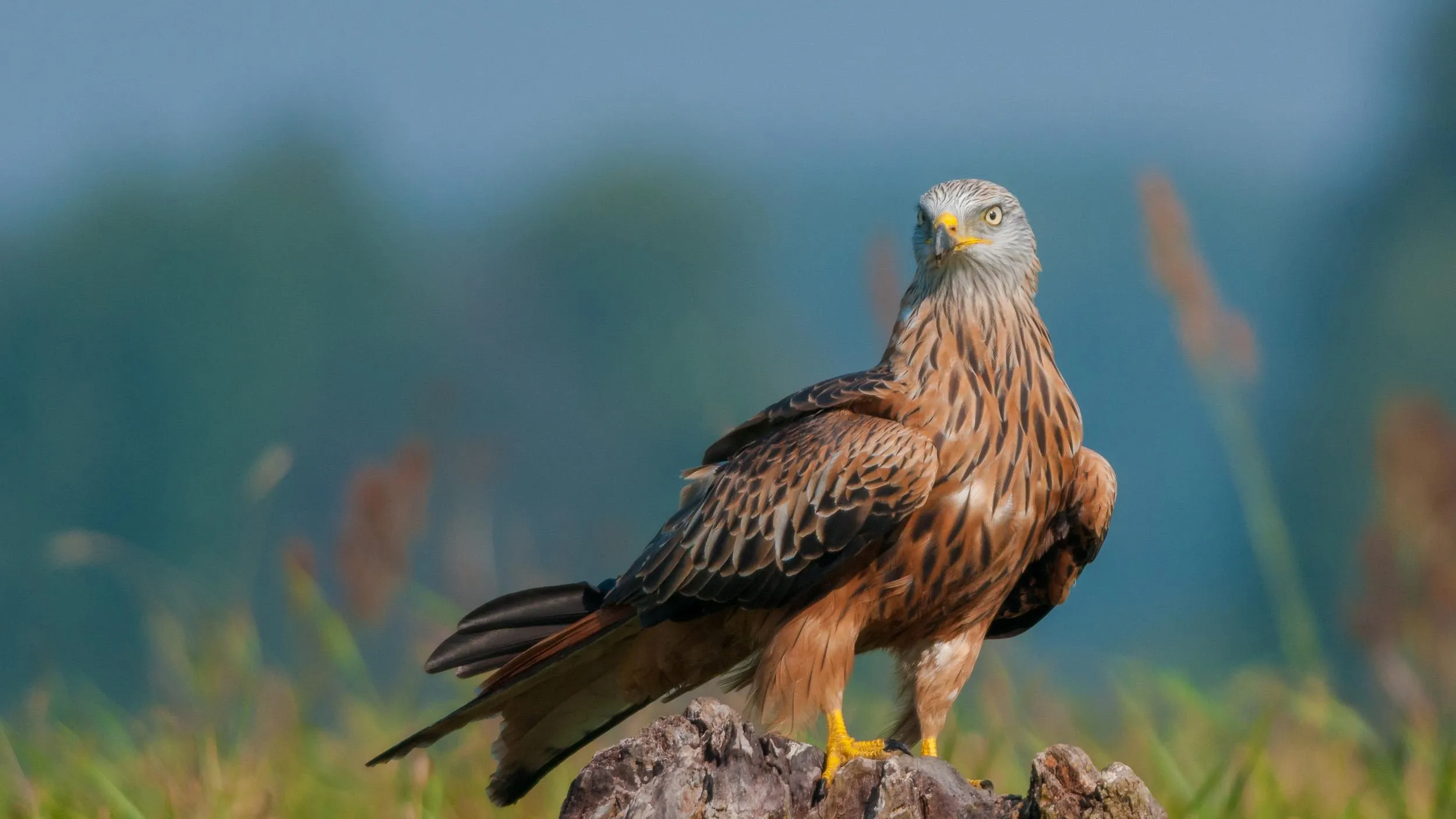
- Length: 60–66cm
- Wingspan: 175–195cm
- Weight: 800–1,300g
Behaviour
Red Kites mainly feed on carrion and can often be seen soaring high above roads, on the lookout for roadkill. When soaring they constantly adjust the angle of their tail to steer, while barely moving their wings. Listen out for their characteristic whistling ‘peee eooo eooo’ call.
When to see them
All year round
Where to see them
Thanks to a reintroduction project, Red Kites have made a remarkable comeback from the brink of extinction in the UK. They’re now found across much of Wales, and central and eastern England, as well as parts of northern England, Scotland and Northern Ireland. You might see them flying over woodland, open countryside and even towns.
Hen Harrier
Conservation status - Red
Key features to look out for
- Slim, medium-sized bird of prey
- Males are blue-grey above, with a paler underside and black tips to their wings
- Females are mainly brown, with a streaked body and wings, and bars on their tail
- Both males and females have a noticeable white rump
- Rounded, owl-like face shape
- Yellow beak with a black tip
- Yellow legs and feet
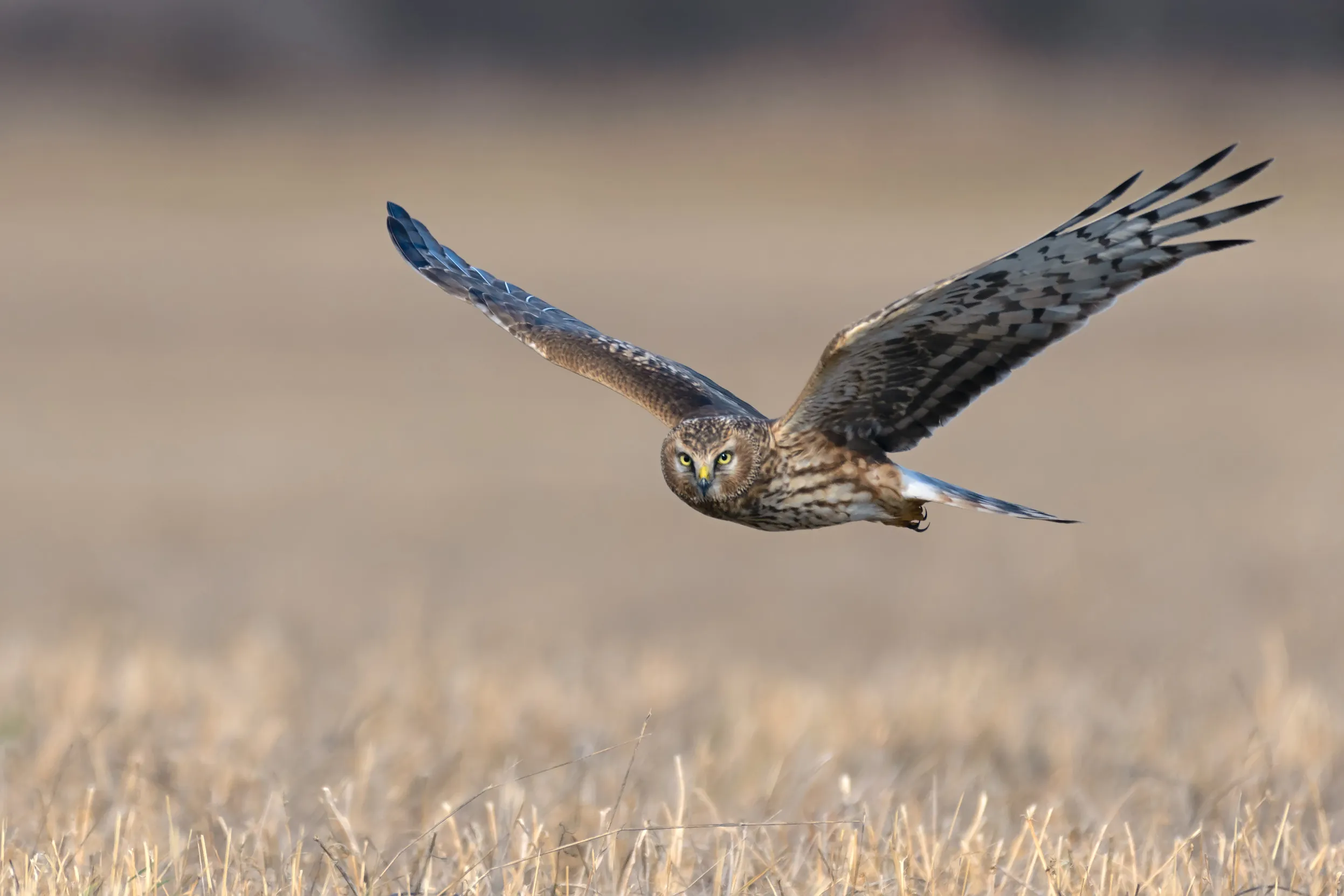
- Length: 44–52cm
- Wingspan: 100–120cm
- Weight: males 300–400g, females 400–600g
Behaviour
Hen Harriers often glide low to the ground, with their wings held in a shallow ‘V’, as they search for food, including small birds and rodents. If you’re really lucky, you might see a male perform his spectacular ‘sky dance’ in spring to impress a female. Males fly high into the air and then plummet downward, twisting and turning as they fall, before pulling up at the last minute and swooping into the air to perform the aerobatic rollercoaster all over again.
When to see them
All year round
Where to see them
Hen Harriers are at home in the uplands, but as a result of intense persecution they are now quite rare and only a handful of pairs still nest in England. They also breed in areas of Scotland, Wales and Northern Ireland. In winter, Hen Harriers leave the uplands and you might see them in lowland and coastal habitats around the UK.
Marsh Harrier
Conservation status - Amber
Key features to look out for
- Larger and stockier than a Hen Harrier, with broader wings
- Females are a rich chocolate brown, with creamy patches on the throat and crown of the head. Juveniles look very similar
- Males are brown above and chestnut underneath
- Males have tri-colour wings: brown closest to the body, then grey, finishing with black wing tips
- Both males and females lack the white rump of a Hen Harrier
- Yellow legs
- Length: 48–56cm
- Wingspan: 115–130cm
- Weight: males 400–660g, females 540–800g
Behaviour
You might see Marsh Harriers flying low over reedbeds, before dropping down to catch their prey of small birds, rodents and even frogs. Like Hen Harriers, male Marsh Harriers perform an impressive sky dance in spring, tumbling towards the ground before swooping back up. Sometimes a female will join in, flipping herself upside down and locking talons with the male in mid-air. Marsh Harriers also hold their wings in a distinctive ‘V’ shape while flying.
When to see them
Marsh Harriers are typically migrant birds that arrive in the UK in spring to breed, before heading back to Africa in autumn. However, many birds now overwinter in the UK.
Where to see them
As their name suggests, Marsh Harriers are birds of marshes and reedbeds. They also hunt and nest in farmland and the open countryside. They can mostly be found in East Anglia, Somerset and the south-east, as well as north-west England and parts of Wales and Scotland.
Osprey
Conservation status - Amber
Key features to look out for
- Males and females look very similar, with brown upperparts and white underparts
- Juvenile birds have buff tips to their feathers, giving them a scaly appearance
- Females are larger and tend to have a ‘necklace’ of brown feathers on their chest
- White head with distinctive dark eye ‘mask’
- Black beak
- Adults have yellow eyes, juveniles have orange eyes
- Pale grey legs, not yellow as in many other birds of prey
- Wings angled at the ‘wrist’ making Ospreys look a bit like gulls at a distance
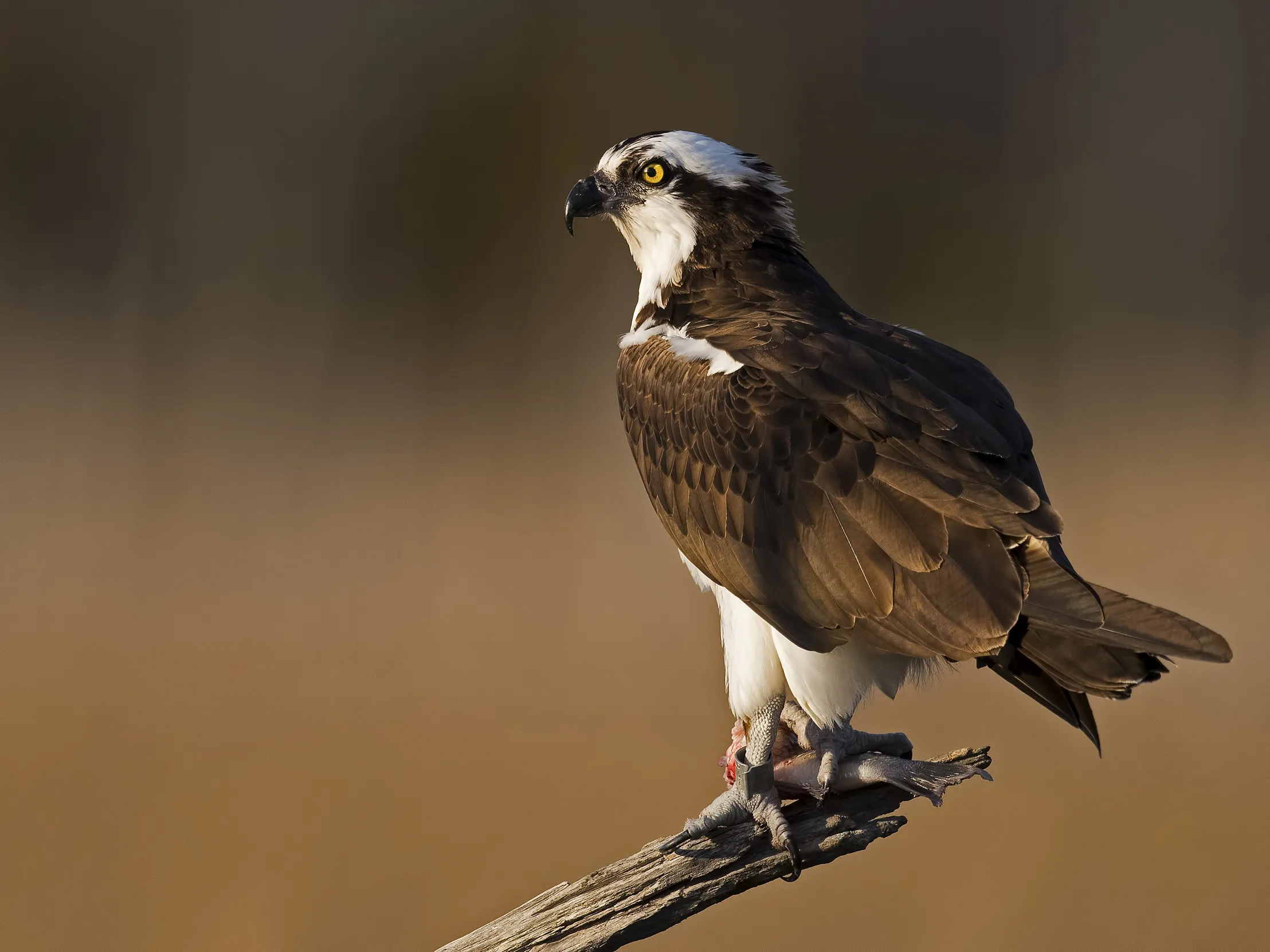
- Length: 52–60cm
- Wingspan: 145–170cm
- Weight: 1,200–2,000g
Behaviour
Ospreys are fish-eating birds of prey and you might see them soaring over a lake peering intently into the water, before hurtling downwards and diving in head-first, with their talons outstretched to grab their prey. They will also fly low over the water to snatch any unsuspecting fish that swim close to the surface. To help them keep hold of their slippery prey, Ospreys have special spines on their feet and will hold the fish headfirst to limit air resistance and help with flight.
When to see them
Ospreys arrive in the UK in about March and return to Africa in autumn.
Where to see them
Ospreys breed by lochs and lakes. They’re increasing as a breeding bird and nesting in more and more places, but Scotland remains their stronghold. You might also spot them further south as they pass through on migration.
Large birds of prey
Golden Eagle
Conservation status - Green
Key features to look out for
- A huge bird of prey, much bigger than a Buzzard – in the UK only the White-tailed Eagle is bigger
- Adults are mostly brown, with lighter feathers on the head and neck which look golden in the sunlight
- Juveniles are darker, with a white base to the tail and white patches in the underwing
- Wings much longer than a Buzzard’s, with pronounced ‘fingered’ tips
- Fan-shaped tail that is longer than a White-tailed Eagle’s
- Chunky black beak with yellow at the base
- Yellow feet
- Feathers on the legs right the way down to the feet, which look a bit like feathery trousers
- Flies with slow, deep wingbeats
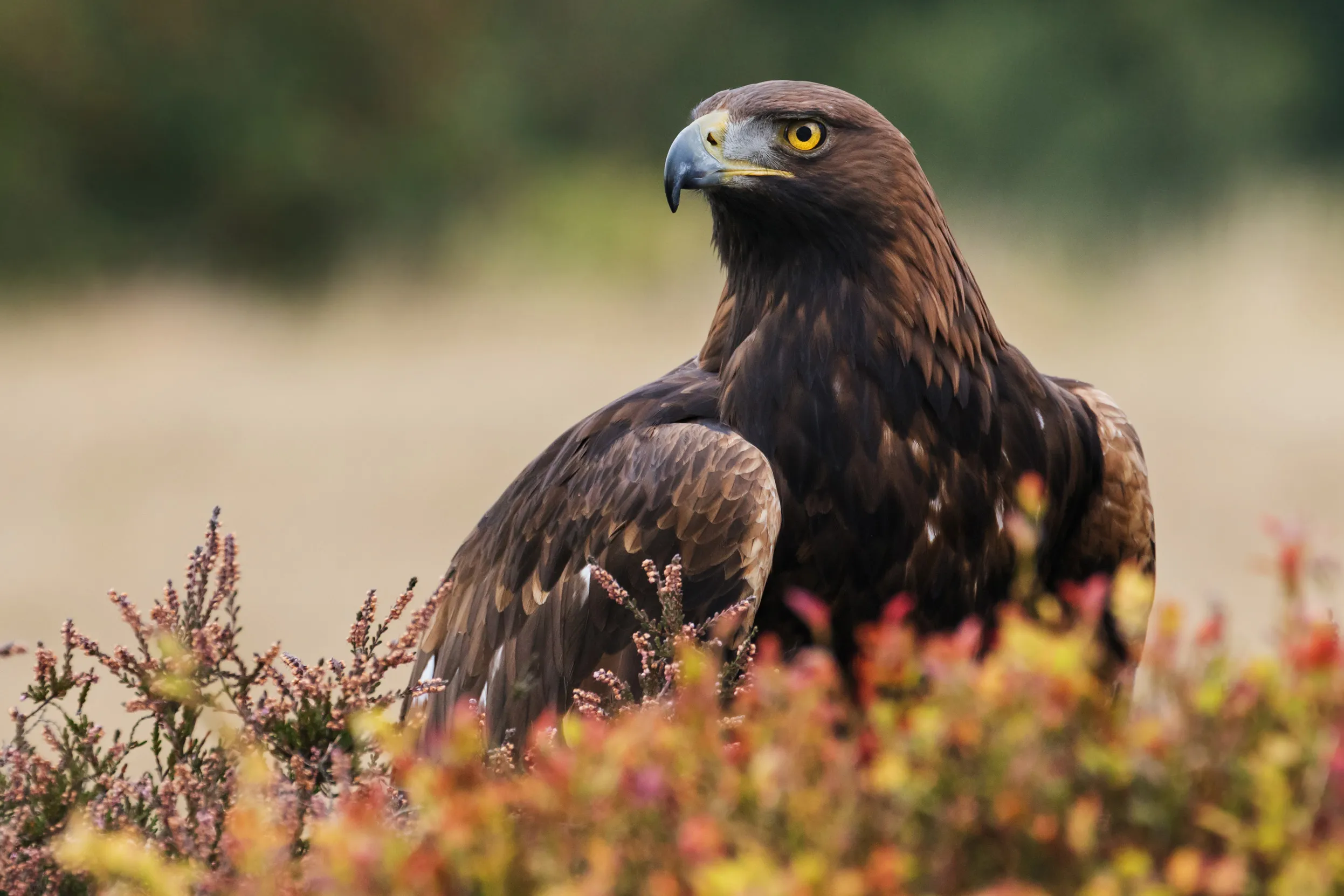
- Length: 75–88cm
- Wingspan: 204–220cm
- Weight: males 2,800–4,500g, females 3,800–6,600g
Behaviour
With a wingspan of more than two metres, Golden Eagles can glide on thermals for huge distances, looking out for prey, such as rabbits, far below. In fact, they have some of the best eyesight in the animal kingdom and can spot a rabbit from about two miles away!
When to see them
All year round
Where to see them
You’re most likely to see Golden Eagles soaring over moorlands and mountains. They used to be quite widespread in the UK, with birds found in Scotland, north Wales, Ireland, and as far south as Derbyshire in England. As a result of persecution, they’re now only found in parts of Northern Ireland, as well as the Scottish Highlands and islands. When in Scotland, people often hope they’ve seen a Golden Eagle, but Buzzards are far smaller and much commoner!
White-tailed Eagle
Conservation status - Amber
Key features to look out for
- A massive, heavy-set bird of prey – the UK’s biggest
- Brown body with a noticeably pale head and neck, which can become almost white in older birds
- Enormous, broad wings – much broader than a Golden Eagle’s – with fingered ends
- Huge, chunky yellow beak (dark in juveniles) and yellow feet
- Adults have white tail feathers, as their name suggests
- Soars with wings held flat, rather than in a ‘V’ shape like Golden Eagles

- Length: 70–90cm
- Wingspan: 200–240cm
- Weight: males 3,500–5,000g, females 4,000–7,000g
Behaviour
When soaring, their enormous wings look almost rectangular, giving White-tailed Eagles their nickname of ‘flying barn doors’. Unlike Golden Eagles, they will catch fish, so you might spot them plunging their talons into the sea or a lake to pluck out a meal. They also eat rabbits, hares and other mammals, as well as birds, such as gulls and ducks, and carrion.
When to see them
All year round
Where to see them
White-tailed Eagles are also known as Sea Eagles, which gives a clue to their preferred habitat – coasts. Like Golden Eagles, they suffered high levels of persecution and as a result their range was limited to the west coast of Scotland and the Scottish Islands, but they have recently been reintroduced to the Isle of Wight and are now much more visible in England, especially along the south coast.
Protect our birds of prey
Despite laws designed to protect them, birds of prey are still being shot, trapped and poisoned across the UK.

Support the RSPB’s Investigations Team today and help us keep these magnificent birds in our skies, where they belong.






